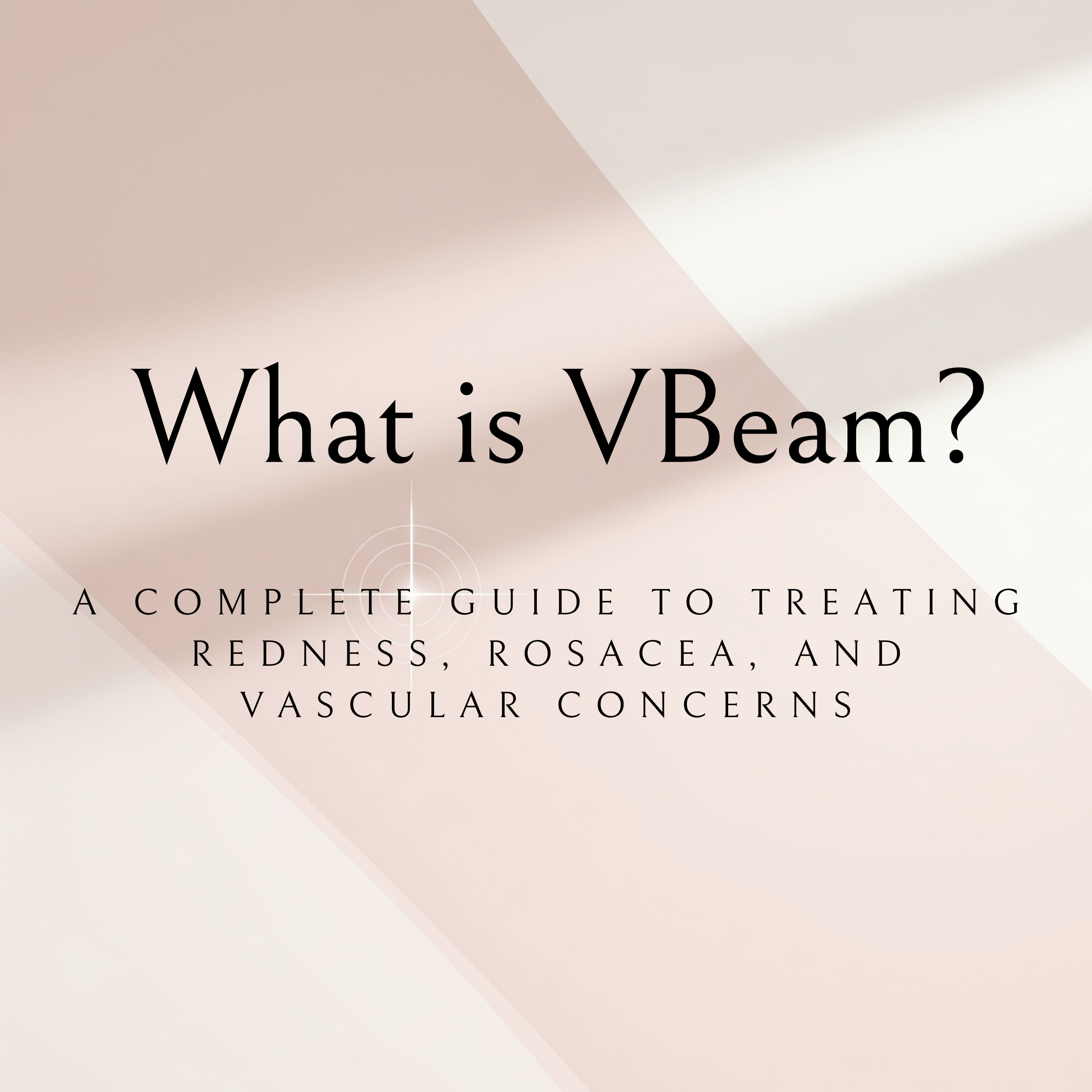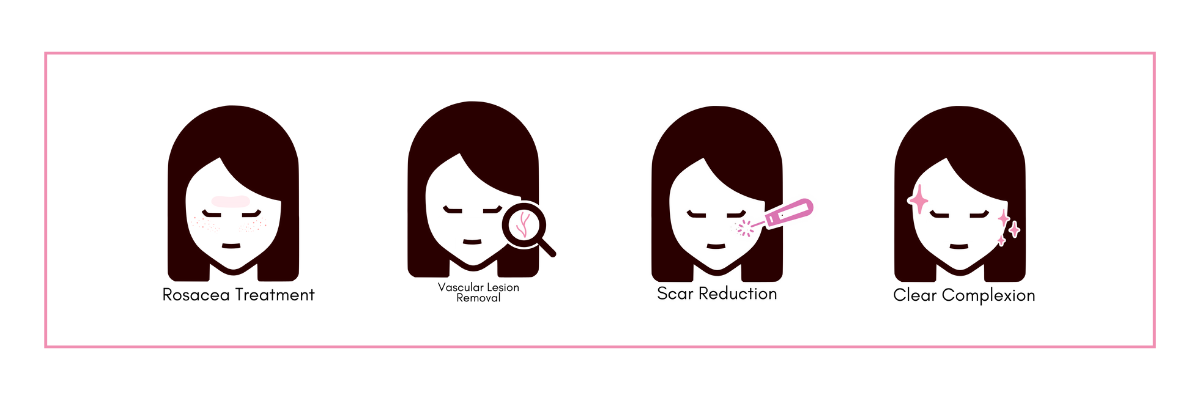
What is VBeam? A Complete Guide to Treating Redness, Rosacea, and Vascular Concerns
Clear, balanced skin is something many people hope for, especially when issues like persistent redness, rosacea, or broken capillaries affect daily confidence. VBeam treatment is a gentle yet effective non-invasive laser treatment designed to target blood vessels beneath the skin’s surface, helping reduce redness, calm inflammation, and restore a more even tone.
If you’ve been wondering whether VBeam could be the right solution for your skin concerns, here’s a complete guide to help you understand how it works, what it treats, and what to expect.
What is VBeam?
VBeam is a pulsed dye laser (PDL) treatment that delivers concentrated light energy into visible blood vessels in the skin. These vessels absorb the light and are gently broken down, allowing the body to clear them over time naturally.
Because it is highly specific in its targeting, VBeam treats redness and vascular concerns without damaging the surrounding skin. It is most commonly used for:
- Rosacea
- Spider veins and broken capillaries
- Port wine stains
- Red acne marks and scars
- General skin flushing or persistent redness
Expert Insight
“VBeam Perfecta, also known as a redness laser or vascular laser, is a fundamental laser essential for scar treatment, as it is featured in American and Korean dermatology textbooks.”
— Dr. Kim Soo-young, Director of SY Dermatology

Benefits of VBeam
- Reduces redness and flushing by targeting overactive or visible blood vessels.
- Improves rosacea symptoms, helping skin look calmer and more even-toned.
- Fades red acne scars, giving smoother, clearer skin over time.
- Minimal downtime — most people can return to normal activities right after.
- Safe for sensitive areas like the face, neck, and chest.
- Boosts skin clarity and can improve overall skin confidence.
Risks and Side Effects of VBeam
VBeam is generally safe, but like any laser treatment, there may be temporary side effects:
- Mild redness or swelling (like a light sunburn) that fades in a few hours to days
- Temporary bruising or purplish spots (“purpura”), depending on treatment settings
- Sensitivity in the treated area for a few days
Working with a qualified dermatologist ensures treatment is tailored to your skin, minimizing risks and improving results.
Is VBeam Right for You?
VBeam is designed for people who want a safe, non-invasive way to treat redness, rosacea, or vascular concerns without long recovery times.
Since every skin is different, starting with an AI Skin Analysis can help you understand your skin type first and see if VBeam is the best fit for your needs.
Ideal Candidates
VBeam may be a good choice if you:
- Struggle with rosacea or frequent flushing
- Have visible spider veins or broken capillaries
- Want to fade red acne scars or post-inflammatory redness
- Prefer a gentle, non-surgical treatment with minimal downtime
- Are looking for clearer, more even-toned skin
Who Should Avoid VBeam
VBeam may not be recommended if you:
- Sensitive skin: Try to avoid, but specific mild settings may be suitable under a dermatologist's supervision
- Have a darker skin type (Fitzpatrick V–VI), as there is a higher risk of pigmentation changes
- Are experiencing active skin infections, eczema flares, or severe acne breakouts
- Are pregnant or breastfeeding
- Expect instant, dramatic results in a single session (multiple treatments are often needed)
VBeam for Your LuluTI Skin Type: Who Sees the Best Results
VBeam is great for people with persistent redness, rosacea, and vascular concerns. It targets the hemoglobin in visible blood vessels to reduce flushing and inflammation and is a go-to for calming the skin and evening out tone. It also helps with red post-acne marks and certain vascular scars.
From the LuluTI perspective, VBeam is best for skin types with an “A” (Acne) profile, particularly when breakouts leave lingering redness. It may also provide secondary benefits for “P” (Pigmentation) and “W” (Wrinkle/loss of firmness) profiles, as some patients notice improvement in sun spots or fine lines as part of the overall skin renewal process.
Even if you have an “U” (Unflawed) profile and your primary concern isn’t acne, VBeam can reduce general redness and some forms of pigmentation, so it’s a good option for overall skin clarity and evenness.
To see if VBeam is right for you, get a Lululab AI Skin Analysis. It will provide you with a clear understanding of your skin and help you find the most suitable treatment for you.
Types of VBeam Lasers
VBeam has evolved into several models, each designed with unique features to address different skin concerns while maintaining the same reliable pulsed dye laser (PDL) foundation. Whether the goal is to gently treat general redness, target deeper blood vessels, or achieve faster, more comfortable sessions, each variant offers a tailored approach.
This means your provider can select the version best suited to your skin’s needs while ensuring the proven safety and effectiveness that VBeam Laser treatment is known for.
VBeam Type | Wavelength(s) | Best For | How It Works | Tips for Sensitive Skin |
|---|---|---|---|---|
VBeam Perfecta® | 595 nm | Redness, rosacea, spider veins, acne scars, vascular & pigmented lesions | Delivers pulsed-dye energy in micropulses, paired with cryogen cooling, to collapse visible blood vessels while protecting the surrounding skin gently | Gentle enough for most skin types, including sensitive skin, due to its adjustable pulse settings. |
VBeam Pro® | 595 nm & 1064 nm | Deeper veins, stubborn redness, vascular lesions, pigmentation, fine lines | Uses dual wavelengths and larger spot sizes for deeper penetration, faster treatment, and less discomfort | More powerful and penetrates deeper, which may trigger redness or irritation in sensitive skin. |
VBeam Prima | 595 nm & 1064 nm | Rosacea, port-wine stains, deeper vascular lesions, and pigmentation | Offers greater depth and precision, targeting both superficial redness and deeper vessels while also addressing pigmentation | Strongest option with deep reach, so sensitive skin requires extra care and customized settings. |
The VBeam family includes devices like the VBeam Perfecta and VBeam Prima, both designed around pulsed dye laser (PDL) technology but optimized for different skin needs. While Perfecta is widely trusted for treating redness, rosacea, and vascular lesions with precision, Prima offers enhanced power, dual wavelengths, and larger spot sizes for faster, more versatile treatments.
What to Expect After VBeam: Timeline and Results
▶ Right after treatment:
Skin may appear slightly red or swollen. Some patients may notice small, purplish spots where the vessels were treated. This is temporary and part of the healing process.
▶ First week:
Redness and bruising (if any) begin to fade. Makeup can usually be applied within 24 hours to cover temporary discoloration.
▶ 1 to 2 weeks:
Skin tone begins to look more even, with a visible reduction in redness or flushing. Acne marks or scars may also start to fade.
▶ Multiple sessions:
Most people need 3–5 treatments, spaced about 4–6 weeks apart, for optimal results. Each session builds on the last, gradually clearing vascular concerns while allowing safe healing.
▶ Ongoing improvement:
Results continue to refine over weeks, with lasting improvements in redness, scars, and skin clarity. Maintenance sessions may be recommended for chronic conditions, such as rosacea.
VBeam Aftercare: Tips for the Best Results
- Protect your skin from the sun: Daily SPF is essential to maintain results and prevent redness from returning.
- Avoid harsh skincare products: Skip exfoliants, scrubs, and retinoids for at least a week.
- Keep skin cool and calm: Avoid hot showers, saunas, or strenuous exercise for 24–48 hours post-treatment.
- Moisturize gently: Hydration supports recovery and keeps skin comfortable.
- Follow your provider’s advice: Personalized instructions ensure your treatment works best for your skin.
VBeam vs IPL (Intense Pulsed Light): Which Treatment is Best for You?
VBeam (Pulsed Dye Laser)
VBeam uses pulsed dye laser technology that targets blood vessels beneath the skin. This makes it highly effective for treating redness, rosacea, broken capillaries, and other vascular concerns. Because of its precision, it often requires fewer sessions to deliver noticeable results.
IPL (Intense Pulsed Light)
IPL uses broad-spectrum light that can treat both pigmentation and mild redness at the same time. It works well for sun damage, freckles, brown spots, and overall complexion improvement, but it is less targeted than VBeam for vascular issues.
In summary, VBeam is the better choice if your primary concern is redness, rosacea, or vascular conditions. At the same time, IPL is ideal for those who want a broader treatment that addresses pigmentation along with mild redness for an overall brighter skin tone.
Next Steps
If you are considering VBeam, the first step is a consultation with a dermatologist or certified laser specialist. They will assess your skin type, discuss your goals, and develop a personalized plan that ensures safe and effective results.
VBeam FAQs: Everything You Need to Know Before Starting
1. How many sessions will I need?
Most people need 3–5 treatments, spaced 4–6 weeks apart.
2. Is VBeam painful?
You may feel a quick snapping sensation, like a rubber band on the skin. Cooling sprays or numbing cream can make it more comfortable.
3. How long does each session take?
Usually 15–30 minutes, depending on the area treated.
4. Can VBeam treat acne scars?
Yes, it works well for red acne scars, especially in combination with other treatments.
5. When will I see results?
Some improvement is visible within a week, with results continuing to build over multiple sessions.

